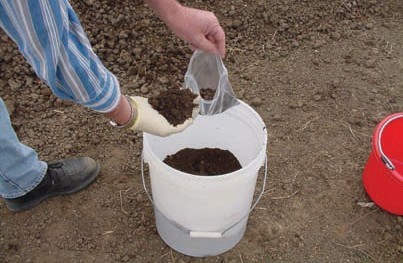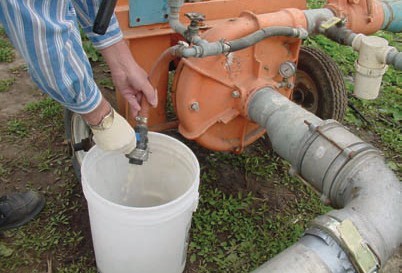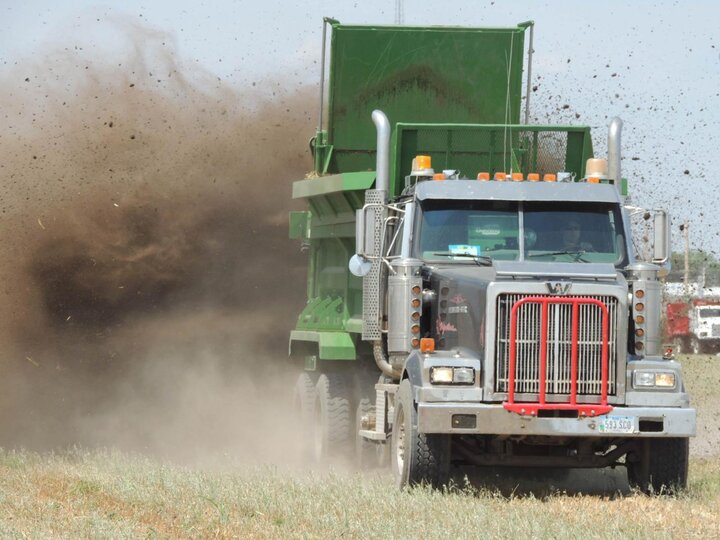Manure Nutrient Analysis
Default values for manure nutrient concentrations are typical values, but concentrations can vary substantially from these due to the feeding program, type of animal housing, and manure handling system. Additional variation occurs within animal feeding operations due to time of year and weather conditions. It is important in an Annual Plan to accurately determine the nutrient content of manure. Therefore, it is necessary to collect representative samples at the time of land application or as close as possible to application.
Sampling Manure for Nutrient Analysis
Manure can be sampled from the feedlot, the manure storage pile or pit, the application spreader, or by collecting samples during application. Sampling in the field insures that losses that occur during handling, storage, and application are taken into account. The time of year and weather conditions also affect manure nutrient concentrations. Accurate determination of manure nutrient content is important for development of a good Annual Plan. Representative manure samples need to be collected at or near the time of manure application periods for each manure facility to determine nutrient contents. Refer to Sampling Manures for Nutrient Analysis for more information.


A representative manure sample is composed of several sub-samples collected from various parts of the manure storage facility. The number of sub-samples required changes with the variability of manure. The number of sub-samples may be as few as 10 if hand-grabbing from a manure spreader or taken while pumping to load a tank spreader or through an irrigation system. Twenty sub-samples may be needed if sampling from open lots or from a liquid storage facility. Samples collected in the field during application by catching solid manure on tarps or liquid manure in pans should have eight to ten sub-samples. After sub-samples are compiled and mixed well, a sample should be put in a suitable container for shipment to a lab.
Manure Analyses
Manure organic nitrogen, ammonium nitrogen, phosphorus and water content are of greatest interest to most producers. Potassium and salt content may be important. The concentrations of calcium, magnesium, sulfur and micro- nutrients are generally of less interest.
Manure nitrogen is primarily in two forms: stable organic nitrogen and unstable ammonium nitrogen (normally nitrate-N is present in only small amounts). Organic nitrogen is slowly released over several years as the manure decomposes with 25 to 35 percent of the organic nitrogen released in the first growing season. It is estimated that 15, 7 and 4 percent of organic nitrogen become available in the subsequent 2-4 years. Ammonium nitrogen and nitrate nitrogen are immediately available to plants, but much can be lost as ammonia gas if improperly managed.
Crop availability of phosphorus and potassium in manure is more easily predicted. Seventy percent of phosphorus and 90 percent of potassium in manure are estimated to be available during the first growing season.
Results of manure analyses are typically reported as concentration (percent or ppm) for the sample as received and on a dry weight basis, as well as in pounds per unit of application. The units of application are tons per acre for solids, 1000 gallon per acre for slurries, and acre-inches for liquids. Request the laboratory to report the results in units of greatest value to the producer's situation.
Manure Application

The process of manure application is driven primarily by the type of manure to be applied – namely solid, slurry, or liquid. The goal with any type of application system should be to maximize the agronomic benefit from manure application and to minimize the environmental impact.
Deciding Where and When to Apply Manure
Manure should be applied to fields, and areas within fields, where it will be most beneficial to crop growth. Consider soil fertility levels in the field — will manure application increase crop yield potential? Are there areas of low fertility (low organic matter or eroded areas) that manure will help improve? Are there areas where manure has recently been applied that should be avoided? Application considerations should also include the potential for environmental impact. Will application to sloping hillsides allow opportunity for runoff into nearby streams? Maintain an appropriate buffer area around streams and wells. Do not apply manure to frozen ground unless it is relatively flat and remote from surface water.
The cost of transportation is a significant factor in manure application. The further the field is from the manure resource, the more expensive it will be to apply it to the field. The nutrient value of the manure will help offset the transportation cost by replacing commercial fertilizer input costs. Unfortunately, soils surrounding livestock facilities often have very high nutrient levels due to excessive manure application. Look for ways to reduce volume when handling manure, such as composting dry manures, or minimizing dilution of slurries with water. This will make the transport of manures over greater distances more cost- effective and allow nutrients from manures to be more effectively used on lower fertility fields.
Avoid situations that will be a nuisance to neighbors when applying manure. Try to apply when prevailing winds will carry odors away from nearby homes or businesses. Avoid application during warm, humid weather. Inject slurries rather than broadcast them on the surface. Incorporate surface-applied manures, either dry or liquid, within 24 hours after application or little odor reduction will result.
Ensure Accurate Application
The first step in accurate application is to calibrate the applicator — a step often avoided by producers because of the belief that calibration of a manure applicator is not a pleasant task. However, calibration need not be a difficult or messy job. Accurate application also means the manure is distributed as uniformly as possible across the swath width, and that swaths are equally spaced across the field.
Injection of liquid manures allows the greatest retention of nutrients, reducing or eliminating the potential for ammonia volatilization and runoff. Injection also minimizes odor concerns. If injection of liquid manures is not possible, or if dry manure is broadcast, incorporate the manure as soon as possible.
Salts in Manure
Manure may contain high levels of soluble salt. High rates of manure application can result in soil salt levels which are detrimental to crop growth. Another concern may be salts in effluents applied to growing crops through sprinkler irrigation systems with the salts burning the plant tissue. Total salt concentration is measured by electrical conductivity (EC).
Crops vary in tolerance to salt in soils (see table). Barley has a very high level of tolerance to soluble salts with an expected yield loss of 10 percent at an EC reading of 10 mmho/cm. On the other hand, corn has a low level of tolerance and suffers a 10 percent yield loss at an EC reading of 3 mmho/cm. Soil is considered to be saline when soil EC is 4 mmho/cm or greater.
If effluent that is to be applied to a crop through a sprinkler irrigation system has an EC greater than 6 mmho/ cm, there is potential for leaf burn and the effluent should be diluted to prevent salt damage to the plants.
Soil Electrical Conductivity (mmho/cm)
| Crop | Tolerance Level | 0 % | 10 % | 50 % |
|---|---|---|---|---|
| Yield Reduction | ||||
| Barley | Very High | 8 | 10 | 18 |
| Sugar Beets | Very High | 7 | 9 | 15 |
| Wheat | High | 6 | 7 | 13 |
| Soybean | Medium | 5 | 5 | 7 |
| Sorghum | Medium | 4 | 5 | 11 |
| Alfalfa | Low | 2 | 3 | 9 |
| Corn | Low | 2 | 3 | 6 |
| Dry Beans | Low | 1 | 2 | 4 |
Estimating soluble salt concentration in manure
- Divide EC (mmho/cm) by 15 to estimate soluble salt concentration as percent of manure.
- Multiply EC (mmho/cm) by 640 to estimate soluble salt concentration as parts per million of manure.
- Multiply by 2 the sum of the percentages of potassium, calcium, magnesium, and sodium to estimate soluble salt concentration as percent of manure.
Part I of Crop Planning | Part II - Soil Testing | Part III - Manure Nutrient Analysis and Application | Complete the Quiz